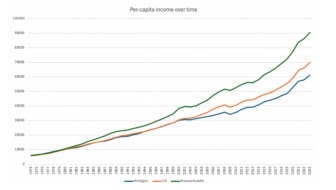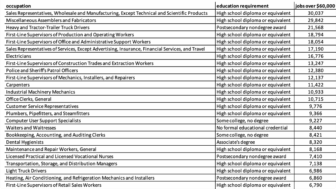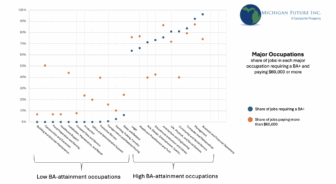
Michigan was one of the most prosperous places on the planet in 1979. Its per capita income three percent above the national average. No more! In 2022 Michigan’s per capita income was 13 percent below the nation’s. The worst Michigan has even been compared to the nation.
The prime reason for this four decade long decline is Michigan has gone from a state with lots of good-paying jobs to a state with far too many low-wage jobs. The American mass middle class is now dominated by professionals and managers who before the pandemic work in offices, schools and hospitals. Michigan workers are under-concentrated in these higher-paid occupations compared to the nation.
It turns out in addition to this under-concentration in higher-paying occupations, Michigan is a low-wage state in all occupations irrespective of education attainment. You can see that clearly when you look at median wages for full time workers 25 and older. (All of the data below are for for those full time workers 25 and older.)
In 1979 Michigan median wages were an astonishing 19.2 percent above the nation’s. Now they are 9.6 percent below. If Michigan’s median wages were still 19.2 percent above the nation’s the typical Michigan worker would be be earning $19,518 more: $80,695 rather than today’s $61,178.
Michigan was a high-prosperity state in 1979 largely due to highly-paid, unionized, overwhelmingly male, hourly workers primarily in the auto industry. General Motors was America’s largest employer. With a little more than 600,000 American employees, around 450,000 of them highly-paid hourly workers. Hourly manufacturing workers were the core of Michigan’s–and the country’s–mass middle class.
More broadly 1979 was a time when male Michigan high school graduates were highly paid compared to their counterparts across the country. With median wages 13.7 percent higher. The typical male Michigan high school graduate made slightly more that the median for all male American workers and 90.9 percent of the median for all male Michigan workers.
Today it is a completely different story. Median wages for male Michigan high school graduates are 2.6 percent less than their counterparts from across the country. And have median wages 23.4 percent lower than all U.S. workers. If male Michigan high school graduates still made as much as all male U.S. workers they would be earning $12,167 more: $52,012 rather than $39,845.
There was a B.A. wage premium for male Michigan workers in 1979. With male Michigan workers with a high school degree having median wages 30.9 percent less than male Michigan workers with a B.A. Today that wage premium has grown to 45.1 percent: $39,845 as compared to $72,604.
So the story we tell ourselves over and over about Michigan use to be a place where one worker––almost always a male––with a high school degree could support a middle class family is accurate. Unfortunately those days are long gone.
The story for female workers is similar. Obviously there are far more women workers today than in 1979. But for those Michigan women who did work in 1979 they enjoyed a median-wage premium compared to their counterparts across the country: 10.7 percent above the nation for all female workers; 10.0 percent for those with a high school degree; and 9.3 percent for those with a B.A.
Four decades later Michigan female workers earn substantially less than their counterparts across the country. 7.5 percent less for all female workers; 8.5 percent less for those with a high school degree; and 4.8 percent less for those with a B.A.
If the typical Michigan female worker still earn 10.7 percent more than the typical American female worker, she would be earning $7,175 more: $43,713 compared to today’s median of $36,538.
Depressingly Michigan male workers still earn substantially more than Michigan female workers. In 1979 median wages for Michigan women was 52.4 percent of Michigan male workers; today it is 70.8 percent of Michigan male workers.
So it turns out Michigan has both a occupational and industry mix problem––too few jobs in knowledge-based occupations and industries––and a wage level problem in both high education attainment occupations and low education attainment occupations. To return to high-prosperity––a place with a broad middle class––Michigan both needs to grow jobs in high-paid occupations and to increase wages in all occupations.







